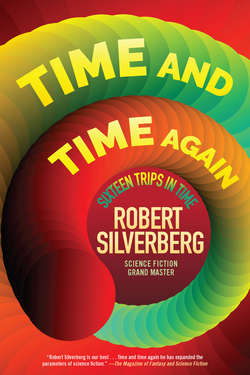Читать книгу Time and Time Again - Robert Silverberg - Страница 12
На сайте Литреса книга снята с продажи.
ОглавлениеHOMEFARING
I had always had a sneaking desire to write the definitive giant-lobster story. Earlier science fiction writers had preempted most of the other appealing monstrosities—including giant aunts (sic!), dealt with by Isaac Asimov in his classic story “Dreamworld,” which I have just ruined forever for you by giving away its punchline. But giant lobsters remained fair game. And when George Scithers, the new editor of the venerable science fiction magazine Amazing Stories, asked me in the autumn of 1982 to do a lengthy story for him, I decided that it was time at last for me to give lobsters their due.
The obvious giant-lobster story, in which horrendous pincer-wielding monsters twenty feet long come ashore at Malibu and set about the conquest of Los Angeles by terrorizing the surfers, might work well enough in a cheap Hollywood sci-fi epic, but it wouldn’t have stood much chance of delighting a sophisticated science fiction reader like Scithers. Nor did it have a lot of appeal for me as a writer. Therefore, following the advice of the brilliant, cantankerous editor Horace Gold, one of my early mentors, I searched for my story idea by turning the obvious upside down. Lobsters are pretty nasty things, after all. They’re tough, surly, dangerous, and ugly—surely the ugliest food objects ever to be prized by mankind. A creature so disagreeable in so many ways must have some redeeming feature. (Other than the flavor of its meat, that is.) And so, instead of depicting them as the savage and hideous-looking critters they really are, what about putting them through a few hundred million years of evolution and turning them into wise and thoughtful civilized beings—the dominant life-form, in fact, of a vastly altered Earth?
A challenging task, yes. And made even more challenging for me, back there in the otherwise sunny and pleasant November of 1982, by the fact that I had just made the great leap from typewriter to computer. “Homefaring” marked my initiation into the world of floppy disks and soft hyphens, of backup copies and automatic pagination. It’s all second nature to me now, of course, but in 1982 I found myself timidly stumbling around in a brave and very strange new world. Each day’s work was an adventure in terror for me. My words appeared in white letters on a black screen, frighteningly impermanent: one electronic sneeze, I thought, and a whole day’s brilliant prose could vanish like a time traveler who has just defenestrated his own grandfather. The mere making of backups didn’t lull my fears: how could I be sure that the act of backing up itself wouldn’t erase what I had just written? Pushing the button marked “Save”—did that really save anything? Switching the computer off at the end of my working day was like a leap into the abyss. Would the story be there the next morning when I turned the machine on again? Warily, I printed out each day’s work when it was done, before backing up, saving, or otherwise jiggling with it electronically. I wanted to see it safely onto paper first.
Sometimes when I put a particularly difficult scene together—for example, the three-page scene at the midpoint of the story, beginning with the line, “The lobsters were singing as they marched”—I would stop right then and there and print it out before proceeding, aware that if the computer somehow were to destroy it I would never be able to reconstruct it at that level of accomplishment. (It’s an axiom among writers that material written to replace inadvertently destroyed copy can’t possibly equal the lost passage—which gets better and better in one’s memory all the time.)
Somehow, in fear and trembling, I tiptoed my way through the entire 88-page manuscript of “Homefaring” without any major disasters. The computer made it marvelously easy to revise the story as I went along; instead of typing out an 88-page first draft, then covering it with handwritten alterations and grimly typing the whole thing out again to make it fit to show an editor, I brought every paragraph up to final-draft status with painless little maneuvers of the cursor. When I realized that I had chosen a confusing name for a minor character, I ordered the computer to correct my error, and sat back in wonder as “Eitel” became “Bleier” throughout the story without my having to do a thing. And then at the end came the wondrous moment when I pushed the button marked “Print”—computers had such buttons, in those pre-Microsoft days—and page after page of immaculate typed copy began to come forth while I occupied myself with other and less dreary tasks.
